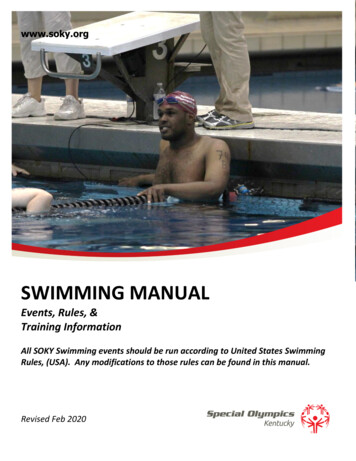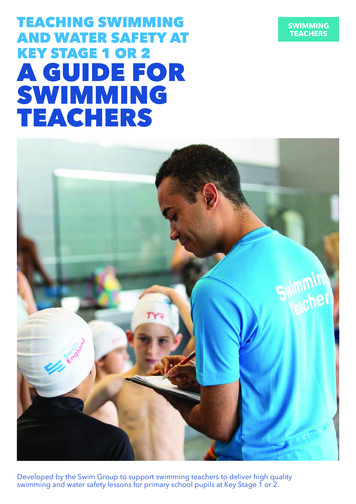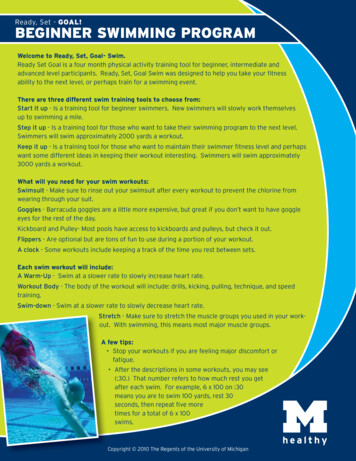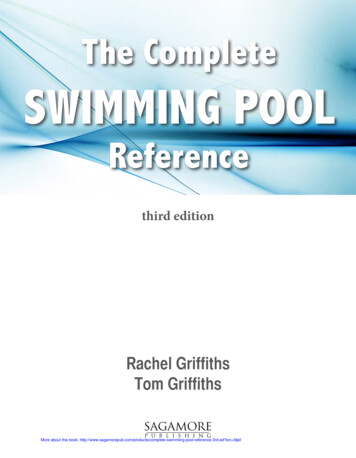
Transcription
SwimmingAbout the TutorialSwimming is one of the popular Olympic sports which has numerous variants. Thistutorial will give you an overview of how to play in swimming competitions, its variantsand the rules to be followed.AudienceThis is an elementary tutorial meant for all those readers who are eager to learnswimming, either for amusement or to participate in swimming competitions.PrerequisiteAll that you need to have is a strong passion and eagerness to learn this sport. Inaddition, we assume that you can swim proficiently.Copyright & Disclaimer Copyright 2016 by Tutorials Point (I) Pvt. Ltd.All the content and graphics published in this e-book are the property of Tutorials Point(I) Pvt. Ltd. The user of this e-book is prohibited to reuse, retain, copy, distribute, orrepublish any contents or a part of contents of this e-book in any manner without writtenconsent of the publisher.We strive to update the contents of our website and tutorials as timely and as preciselyas possible, however, the contents may contain inaccuracies or errors. Tutorials Point (I)Pvt. Ltd. provides no guarantee regarding the accuracy, timeliness, or completeness ofour website or its contents including this tutorial. If you discover any errors on ourwebsite or in this tutorial, please notify us at contact@tutorialspoint.com1
SwimmingTable of ContentsAbout the Tutorial . 1Audience . 1Prerequisite. 1Copyright & Disclaimer. 1Table of Contents . 21.SWIMMING – OVERVIEW . 32.SWIMMING – PLAYING ENVIRONMENT. 5Swimming Pools . 5Swimming Equipment . 63.SWIMMING – HOW TO PLAY? . 7Butterfly . 7Back Stroke . 8Breast Stroke. 10Free Style . 114.SWIMMING– VARIANTS. 135.SWIMMING – TOURNAMENTS . 14Individual Races . 14Relay Events . 14Open Pool Swimming Events . 15Swimming Events at the Olympics 2012 . 166.SWIMMING – CHAMPION OF CHAMPIONS . 182
1. Swimming – OverviewSwimmingSwimming is the act of driving our body through water and resisting drowning by movingour hands and feet. Swimming as a recreational activity has been recorded in prehistoriccave paintings of Stone Age. It was mentioned in holy texts of various civilizations. Itevolved as a competitive sport in the nineteenth century after the construction ofartificial public swimming pools. St George's Baths, the first public swimming pool, wasconstructed in England in 1828 and it emerged as a competitive sport in England in1830s. British Swimming organization was set up as National Swimming Society and wasconducting competitions in England in 1837.Competitive swimming as a race was held among swimmers and the goal is to swimfaster than other participants. Various countries started participating in thesecompetitions. Swimmers learnt about indigenous styles of other countries. Theknowledge transfer among swimmers gave birth to many fusion styles. Swimming canbe both an individual and team activity that helps in testing ones endurance, agility,breath control, and flexibility.FINAThe administering body recognized by International Olympic Committee (IOC) forcompetitions in aquatics is FINA or Fédération Internationale de Natation. Apart fromswimming, it also administers competitions in other aquatic sports. This body is based inLausanne, Switzerland. It not only formulates rules for international swimming recordsand competitions but also organizes world swimming and world aquatic championships.3
SwimmingParticipating CountriesMore than 200 nations have member organizations affiliated to FINA. It is a wide sportplayed across all nations and continents. The countries that take part in swimmingtournaments are USA, Australia, Canada, China, Korea, Tunisia, Great Brittan, Japan,Russia, Austria, Romania, Norway, Hungary, Serbia, Ukraine, Trinidad and Tobago,Netherlands, Italy, Germany, and France.4
2. Swimming – Playing EnvironmentSwimmingSwimming PoolsFINA has set rules on the length, breadth, and depth of swimming pools used forcompetitions. Swimming pools should be at least two meters deep. They can be fifty ortwenty five meters long. The fifty meter long ones are used for long course races and thetwenty five meter long ones are used for short course races. World records cannot becompared across pools of different lengths because it may be an advantage ordisadvantage to swimmers to have more or less turns in a race.Pools are divided into lanes. Lanes are labelled from zero and each lane should be atleast 2.5 meters wide. World championship pools have ten lanes. Pools hosting otherevents can have eight lanes. They are usually equipped with starting blocks at both endsof the pool. According to FINA regulations, Automatic Officiating Equipment with touchpads should be used to record times. Sensors are used to monitor takeovers in a relayrace.There have been major changes in starting blocks over the past few years. Of late, thesurface of the block is angled towards the swimming pool and starting blocks now have araised, slant platform at the end of the main block called a lip. This allows the swimmerto launch with greater speed by taking a right angled crouched position and pushing offwith the rear leg.5
SwimmingSwimming EquipmentSwim SuitsMen's swimwear include briefs and jammers. FINA has formulated some rules to preventswimmers from taking advantage by wearing aerodynamic swim suits. They can wearonly one piece of swim suit from the waist to just above their knees.Women usually wear one-piece suits of various designs at the back. Some of the populardesigns are racer back, axel back, corset, diamondback, and butterfly-back/Fly-Back.The suits can be of various lengths, however they are not allowed to wear suits that gopast their knees or shoulders.Swim capSwaying hair induces drag and slows down the swimmer. Long hair might also obstructvision. A swim cap is used to lock hair and reduce drag. It is made of stretchablematerials like, latex, silicone, spandex or lycra.GogglesSwimmers use goggles to prevent water and chlorine from getting into their eyes. Whileswimming at open pools, swimmers might choose tinted goggles to neutralize glare.Some goggles are also made of vision correcting lenses.6
3. Swimming – How to Play?SwimmingFour major styles have been established in competitive swimming. They are: Butterfly Back Stroke Breast Stroke FreestyleButterflyIn this style, swimmers dive into the pool stretching their arms and shoulders widthapart. They enter the pool either flat or slightly downwards. They rotate their arms in asemi circle to raise the body. The body propels as they push water toward their feet bymoving their hands simultaneously. They push water backwards by synchronouslymoving their feet up and down. They can use dolphin or butterfly kick. This style wasoriginated from the breast stroke and is considered to be the most difficult style.FINA, the international swimming regulating body, accepted this stroke and formed a setof rules in 1952.7
SwimmingRules Swimmers should keep their body on the breast at the start of the race and ateach turn. They are not allowed to roll onto their back at any point during the race. They should synchronously move their arms. They should move their legs simultaneously, though need not be at the samelevel, but they are not permitted to move them alternatively. They are not permitted to use breast stroking leg kick. At each turn and when the race finishes, they should touch the board with boththeir hands and at the same time. They can use one or more leg kicks and one arm pull, but cannot remain in waterfor more than 15 meters, at the start of the race and at the turns. They shouldremain on the water surface unless they have to turn again or they are about tofinish the race.Back StrokeIn this style, swimmers swim on their back. They can breathe easily as their head will beabove water throughout the stroke. However, swimmers cannot see where they areheading. In swimming pools with artificial lanes, most swimmers know how manystrokes they take to reach the end.Swimmers are allowed to turn their heads to see where they are heading, but it slowsthem down. This stroke looks like an inverted front crawl. Swimmers move their arms insemi circular motion, one after the other, to push water towards their legs. While theycatch water with one arm the other arm recovers.They kick water with pointed toes and try to reduce drag by keeping their legs asstraight as possible. Their semi circular arm movement provides them the required push.The axis is longer and is along the swimmers body from head to toe.8
SwimmingAt the start of the race, swimmers place their legs shoulder width apart, facing the walland clinging to the start block. They usually bend their knees at right angle and getready for the race. Once they hear the start signal they push themselves away from thestart block with their feet. They swing their hands and dive into the water on their back.Rules At the beginning of the race, swimmers are not allowed to stand in or on thegutter. They also cannot bend their toes over the lip of the gutter. Swimmers can push off at the start of the race and after turning. At turns, swimmers can turn their shoulders over the vertical to the breast. Afterthat they can use a continuous single arm pull or a continuous double arm pull totake a turn. They should get back on their backs after leaving the wall. Swimmers can slightly roll their bodies over their backs but their body shouldonly make an angle less than 90 degrees with the horizontal. Swimmers should take care to swim with some part of their body over watersurface throughout the race. However, they can stay completely in water at theturns and at the finish of the race for a distance not more than 15 meters. While turning, swimmers should touch the wall with some part of their body.9
SwimmingBreast StrokeThis style is considered to be the oldest. In this style, swimmers stretch their armsforward and tilt their hands slightly downwards. While pulling their hands towards thewaist, they bring their feet closer to the hips and fold their legs and kick water with theirfeet. This propels their body forward and gives them speed. The leg movement is similarto that of a frog, so it is also known as frog kick or whip kick.In this stroke, the greater angle the swimmers’ body makes with the water surface whiletrying to push the water backwards, induces drag and slows down the swimmer.Swimmers master this stroke by learning to reduce drag at the start of the race bykeeping their body, from head to hips, as straight as possible.To gain speed while pushing water backwards during a frog kick, swimmers should try tokeep their heels immersed in water, but as close to the water surface as possible. Theyneed to learn to manage their breath, by pulling in their stomach and bringing their faceabove the water surface, while moving their hands towards their hips.Most long distance swimmers use this stroke. Captain Mathew Webb was the first man toswim across the English channel in 1875. He managed to cover the huge distance usingthis stroke. The relatively smaller arm stroke puts less pressure on swimmers and makesthis stroke ideal for long distance swimming.10
SwimmingRules They should start the race by swimming on their breast. They should separate their hands and take an arm stroke at the start of the race. They should take a leg kick after an arm stroke. An arm stroke and a leg kicktogether make a stroke cycle. At any point during the race, they cannot turn on their back. They should move their hands simultaneously. They should keep their hands at the same horizontal level. While pushing water from the breast, their hands can stay on, under or over thewater surface. Their elbow should always remain in water. However, it can stay above the watersurface at the final stroke before a turn, during the turn or at the end of the race. They can bring back their hands on or under the surface of water. They cannot bring back their hands beyond the hip line, except during the firststroke and each turn. They should turn their feet outwards during the propulsive part of the kick. They can break the surface of water with their feet, but they cannot take adownward butterfly kick immediately after that. At each turn and at the completion of the race, swimmers should touch the wallwith both their hands simultaneously above or below the water level. They can submerge their head after the last arm pull just before the touch, butthey should break the water surface at some point during the last complete orincomplete cycle preceding the touch.Free StyleIn free style races, very few restrictions are placed on the swimmer. The swimmer canchoose to swim in any style. However, front crawl and free style have becomesynonymous as almost all swimmers across the world use front crawl in free stylecompetitions. In this style, swimmers move their arms alternatively forward, pullingwater backwards.They flutter-kick their feet simultaneously. They move one of their arms in a semicircular motion in vertical plane while they catch water with the other arm and push itbackwards. They might also choose to whip kick their feet. This variant is called theTrudgen.11
SwimmingRules Front Crawl is the fastest of the four major styles. Since this style is notregulated, various variants of front crawl like Australian crawl, American crawlcan be used in races. In free style events swimmers can swim in any style. But, in individual medleyand medley relay events, swimmers can swim in any style other than backstroke, breast stroke or butterfly. After swimming through a lane length and at the finish of the race, swimmersshould touch the wall with any part of their body. Swimmers should swim with some part of their body above the water surface,throughout the race. They can remain submerged in water while taking a turnand for a distance not more than 15 meters after the start and each turn.12
4. Swimming– VariantsSwimmingSwimmers are broadly classified as sprinters, middle swimmers, and distance swimmers.They practice differently and have slightly different abilities. Some swimmers are good atall the three forms while some excel in only one or two kinds.Sprinting is intense swimming for a shorter distance. Sprinters practice to put inmaximum effort throughout the swim and concentrate on managing their breath. Theyusually participate in 50, 100 and 200 meter races.Distance swimmers are trained to swim faster for larger distances. They need to enduregreater strain over a long course. A high average speed should be maintainedthroughout the race. They should also learn to relax while not totally dropping theirspeed during the long course. They usually participate in 800 or 1500 meter races.Middle distance swimmers do not drop their speed as fast as a sprinter on a longswimming course. They also tend to have greater initial speed than a long distanceswimmers. They perform well when the track length is not too long and is between 200meters and 400 meters.13
5. Swimming – TournamentsSwimmingThe events in any competition may have only one of the four major styles or acombination of all the four styles in a fixed order.Individual RacesCompetitions are held in each of the major four swimming styles. At the Olympics fiveevents are conducted under free style. They are 50 meter, 100 meter, 200 meter, 400meter, 1500 meter for men and 50 meter, 100 meter, 200 meter, 400 meter, and 800meter for women. Two events, 100 meter and 400 meter are also conducted under allthe other three styles, breaststroke, butterfly and backstroke, for both men and women.Individual medley competitions are also held at various tournaments. In thesecompetitions a single swimmer swims a quarter of the track distance in each of the fourstyles in the same race. At the Olympics, 200 and 400 meter individual medleys areconducted for both men and women. The swimmer swims butterfly, backstroke,breaststroke and finally freestyle in the same order in these medley events.Other kinds of individual medley races of 100 meters, are conducted in other nonOlympics swimming championships. The swimmer should swim at least four strokes ineach of the styles. So, the course length cannot be made any shorter.Relay EventsRelay events are group events. Each country or team participating in the event forms agroup of four swimmers. Each swimmer swims a quarter of the track distance. Thefastest swimmer is usually placed at the end. The team spirit in a group event usuallymakes swimmers swim faster than individual races. Relay events can be both freestyleand medley. In a freestyle relay each swimmer swims in any style other thanbackstroke, breaststroke and butterfly. In a medley relay each swimmer swims a quarter14
Swimmingof the total course length in a different style in the order Backstroke, Breaststroke,Butterfly and Freestyle. A 4 100 meter freestyle relay, a 4 200 meter freestyle relayand a 4 100 meter medley relay events are part of swimming competitions at theOlympics.Open Pool Swimming EventsLong distance free style marathons are conducted in large open water bodies like lakes,rivers and oceans. Swimmers are free to use any style in these events. However, mostswimmers across the globe use front crawl in these competitions.15
SwimmingSince 2008, a 10 km open water swimming championship is a part of the Olympics. FINAalso organizes other open marathon events of 5km, 10 km and 15 km at world aquaticchampionships, held once in every two years.Swimming Events at the Olympics 2012Following are the swimming events held at the Olympics 2012: 50 meter freestyle 100 meter freestyle 200 meter freestyle 400 meter freestyle 1500 meter freestyle for men and 800 meter freestyle for women 100 meter backstroke 200 meter backstroke 100 meter breaststroke 200 meter breaststroke16
Swimming 100 meter butterfly 200 meter butterfly 200 meter individual medley 400 meter individual medley 4 100 meter freestyle relay 4 200 meter freestyle relay 4 100 meter medley relay Marathon 10 km17
6. Swimming – Champion of ChampionsSwimmingSwimming has evolved over time and new styles gave birth to new events and rules. Itis difficult to compare champions across decades. Swimming as a sport is enjoyed andmastered by both men and women. Some of the famous swimming champions are listedbelow.NameNationalityKrisztina Egerszegi (F)HungaryMichael Phelps (M)U.S.ADawn Fraser (F)AustraliaMark Spitz (M)U.S.AShane Gould (F)AustraliaTracy Caulkins (F)U.S.AIan Thorpe (M)AustraliaKrisztina EgerszegiKrisztina is a backstroke swimming champion fromHungary. She participated in the Summer Olympicsat 1988, 1992 and 1996 and won the 200 meterbackstroke in all the three Olympics.At age 14 she became the youngest athlete ever towin an Olympic gold medal in swimming when shewon the 200-metre backstroke at the 1988 OlympicGames in Seoul. After Dawn Fraser, she was thesecond woman to score a gold medal in anyindividual swimming event at three consecutiveOlympics.Michael PhelpsPhelps is an American swimmer. He won 22Olympic medals and holds a record for winning 18Olympic gold medals.Phelps has won six gold medals at the 2004Summer Olympics, eight gold medals at the 2008Summer Olympics and four gold medals at the2012 Summer Olympics.18
SwimmingPhelps is the world record holder in the 100-meter butterfly, 200-meter butterfly and400-meter individual medley. He has won a total of 77 medals in major internationalcompetitions.Dawn FraserFraser is an Australian champion swimmer and isthe first woman swimmer to get gold medals in anyindividual swimming event in three consecutiveOlympics. She won the 100-meter freestyle threetimes in 1956, 1960 and 1964 Summer Olympics.Fraser won eight Olympic medals, includinggold medals, and six Commonwealth Gamesmedals. In October 1962, she became thewoman to swim 100 metres freestyle in lessone minute.fourgoldfirstthanMark SpitzMark Spitz is an American swimming champion. Hewon two gold medals at the 1968 summerOlympics. Spitz set a world record at the 1972Olympic Games, when he won seven gold medalsacross individual and team events. He was a ninetime Olympic champion.Apart from winning gold medals he also won asilver and a bronze medal along with five PanAmerican gold medals.Tracy CaulkinsTracy is an American former competition swimmer.She is considered to be one of the most versatileswimmers and has set U.S records in all the fourstyles. She could not participate in the 1980summer Olympics because the U.S boycotted them.Tracy won three medals at the 1984 summerOlympics. She has set 68 records out of which fiveare world records and 63 are records made inAmerican championships.19
SwimmingIan ThorpeIan Thorpe is an Australian freestyle swimmingchampion, who won five Olympic gold medals, threeat the 2000 Summer Olympics and two at the 2004Summer Olympics. He made his debut in 1997through pan Pacific Championship and got fourthrank in 200 meter freestyle.Thorpe won 400 meter freestyle in Perth WorldChampionship in 1998 and became the youngestchampion. After this he won the races in Olympicsand Common Wealth games.20
Swimming 3 Swimming is the act of driving our body through water and resisting drowning by moving our hands and feet. Swimming as a recreational activity has been recorded in prehistoric cave paintings of Stone Age. It was mentioned in holy texts of various civilizations. ItFile Size: 1MB










